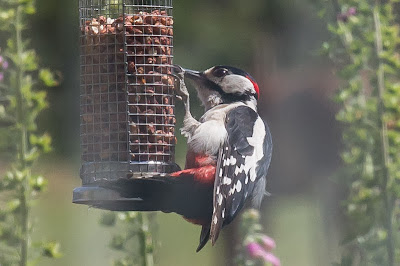Nature's Home is the new title for the
RSPB magazine. And it's on that theme I blog today.
My blog posts have been few and far between, over the last few months, as just over a year ago we moved into an old farmhouse needing some major repairs; new roof, windows, pointing etc. But as someone who is aware of the needs of other species, other than my own, I was always concerned that any works shouldn't preclude the various residents that find crumbly old buildings a cosy place to live. So the first thing to do was to let a few months roll by and see just what was living where......
 |
On opening the bedroom cupboard there was a television. To enable it to fit, a
hole had been knocked into the chimney breast. On top of the back of
the TV was a jackdaw nest. 'Nature's Home' indeed! |
 |
An area of bare ground left after a confer was removed, had some cornfield annuals
seed chucked on it. Yes, that's about all that's needed. No time-consuming
gardening required. The results were blooming marvellous. |
 |
| These Marmalade Hoverflies loved the poppies in their hundreds. |
 |
A number of Black Ant colonies were found along the garden path.
They enjoyed the 'weeds' left to grow, |
 |
A Blackbird finds the hedge a safe place to nest. Other species using the hedge
included Chaffinch and Greenfinch. |
 |
| Buff-tailed Bumblebee nested under the hedge. |
 |
| A Buff-tip Moth caught in moth garden moth trap. |
 |
| A Lesser Yellow Underwing caterpillar found taking shelter under a pot. |
 |
| Collard Dove builds a nest in the Ivy. |
 |
Crocuses brought early spring colour, and an early source of nectar to
emerging bees. |
 |
| Drone fly laying eggs in the small barrel pond. |
 |
| An Elephant Hawkmoth found in my moth trap |
 |
The new 'Swallow House' begins construction. One of two I intend to build to
help mitigate the loss of swallow nest sites resulting from development
planned by my neighbour on his derelict barn. |
 |
| The Swallows should be pleased! |
 |
| A Nettle Tap moth, a Sun-fly and an unknown fly, tuck into a flowering 'weed'. |
 |
| A local fox patrols the hedge row. |
 |
We have lots of frogs, common toads and some palmate newts here.
My neighbour's pond is particularly large so amphibians live here in great numbers.
It even accommodates a Kingfisher that comes to take Sticklebacks! |
 |
| Thistles in the front garden prove tempting for the Goldfinches. |
 |
| The green roof installed on top of my garden container has really taken off! |
 |
Greenfinches nested in the garden hedge in September last year. Just proves
why early hedge cutting isn't a good idea. |
 |
| Green Silver-lines moth found in the moth trap. |
 |
| Great Spotted Woodpecker is a regular visitor to the garden feeders. |
 |
Dicranopalpus ramosus - an alien Harvestman invader from Europe.
There's lots of these in the garden. |
 |
| Leucozona lucorum, a striking hoverfly feeding on Buddleia. |
 |
Jackdaws nested in a hole in our gable end an in a nest box we put up
for Little Owls. |
 |
| A recently fledged Little Owl in my neighbours barn. |
 |
| Long-tailed Tit looking for a invertebrate snack. |
 |
| Phlox provides a source of nectar for this Marmalade Hoverfly. |
 |
Leaf mine on the apple tree caused by the caterpillar of
Lyonetia clerkella, a micro moth. They cause no harm to the
tree as shown by the huge crop of apples this year. |
 |
Marsham's Nomad Bee is a cuckoo bee that seeks out the nests of
other solitary bees. |
 |
Large annual daisies come into their own in late summer, early autumn
as a butterfly magnet. This stunning peacock could't resist. |
 |
Sweet Rocket (Hesperis matronal) growing along the hedge is the food plant for
this tiny moth, Plutella porrectella |
 |
| Hundreds of Poecilobothros nobilitatus 'danced' on the pond to attract a mate. |
 |
Red-tailed Bumblebees nested in the house wall.
We left a few holes when it was pointed. |
 |
| Red Admiral makes a late show in October. |
 |
Red Mason Bees take advantage of the holes in the stone house walls.
When it was pointed we ensured that plenty of nest sites remained. |
 |
| Ruby-tailed Wasp looking for Red Mason Bee nests to lay their eggs. |
 |
| A Shrew in the wall. |
 |
| A large Snail Eating beetle found under the boot brush at the back door. |
 |
| Spiders are in every nook and cranny. |
 |
| Swallow getting vocal. |
 |
| Tree Sparrows raised three broods in a hole in the house this summer. |
 |
At least two wasp nests nearby this year. One in the hedge, and one in a nest box.
Left alone, they didn't cause any problems for anyone while providing
a fantastic pest removal service in the garden. |
 |
| Wolf spider on patrol. |
 |
| Wren nest building in some Ivy. |
 |
| Zebra Spider hunting on the wall |
Now we have a very good idea where everything has it's home we can set about further enhancing habitats, and ensure we don't do anything that upsets our natural neighbours.
















































